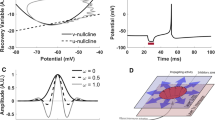Abstract
Gaussian local rate coding (GLR) transforms spike train data into time series data, making it possible to use time series models for neural system identification. A simple computational model is used to represent the dynamics of peripheral electrosensory system of an elasmobranch, and a maximum entropy criterion is used to simultaneously optimize the coding bandwidth and the structure and parameters of the computational model. The computational model may be suitable for other neural systems. The coding model is general and provides a natural definition of neural firing rate.
Access this chapter
Tax calculation will be finalised at checkout
Purchases are for personal use only
Preview
Unable to display preview. Download preview PDF.
Similar content being viewed by others
References
Bialek. W., Rieke, F., De Ruyter van Steveninck, R.R., Warland D., 1991, Reading a neural code, Science 252: 1854–1856.
Bendat,.l.S. and Piersol, A.G., 1986, Random Data: Analysis and Measurement Techniques, Wiley -Inter-science: New York.
Connor, F.R., 1982, Modulation, Edward Arnold Ltd: London.
Hamming. R.W., 1983, Digital Filters, Prentice-Hall: Englewood Cliffs, NJ.
Jaynes, E.T., 1979, Where do we stand on maximum entropy’? In: Levine, R.D. and Tribus, M., eds., The Maximum Entropy Formalism, MIT Press: MA, pp. 15–118.
Kalmijn, A.J., 1982, Electric and magnetic field detection in elasmobranch fishes. Science 218: 916–918.
Kosko, B., 1992, Neural Networks and Fuzzy Systems, Prentice-Hall: NJ.
Miller, J.P., 1994, Neurons Cleverer than we Thought’? Current Biology 4: 818–820.
Montgomery, J.C., 1984, Frequency response characteristics of primary and secondary neurons in the electrosensory system of the thornback ray. Comp. Biochem. Physiol. A79: 189–195.
Murray, R.W., 1960, Electrical sensitivity of the ampullae of Lorenzini. Nature, 187: 957.
Paulin, M.G., 1992, Digital filters for neural firing rate estimation. Biol. Cybernetics 66, 525–531.
Paulin, M.G., 1993a, A method for constructing data-based models of spiking neurons using a dynamic linear–static nonlinear cascade. Biological Cybernetics 69: 67–76.
Paulin, M.G., 1993b, Neural system identification applied to modelling dogfish electrosensory neurons. In: Eckman, F., ed., Computation in Neurons and Neural Systems, Kluwer Academic Press: Boston, pp. 191–196.
Paulin, M.G., 1985, Electroreception and the compass sense of sharks. J. Theor. Biol. 174: 325–339.
Rumelhart, D.E. and McClelland, J.L., 1986, Parallel Distributed Processing: Explorations in the Microstructure of Cognition, MIT Press: MA.
Sakamoto Y., Ishiguro M. and Kitagawa G, 1986. Akaike Information Criterion Statistics, KTK Scientific Press: Tokyo.
Selverston, A.I., 1993, Modelling of neural circuits: What have we learned? Ann. Rev. Neurosci. 16: 531–46.
Tricas, T.C., 1982, Bioelectric mediated predation by swell sharks, CephaloscTllium ventriosum. Copeia, 4: 948–952.
Usher, M.L. 1984, Information theory for information technologists. Macmillan Inc.: London.
Author information
Authors and Affiliations
Editor information
Editors and Affiliations
Rights and permissions
Copyright information
© 1996 Springer Science+Business Media New York
About this chapter
Cite this chapter
Paulin, M.G. (1996). System Identification of Spiking Sensory Neurons Using Realistically Constrained Nonlinear Time Series Models. In: Gath, I., Inbar, G.F. (eds) Advances in Processing and Pattern Analysis of Biological Signals. Springer, Boston, MA. https://doi.org/10.1007/978-1-4757-9098-6_13
Download citation
DOI: https://doi.org/10.1007/978-1-4757-9098-6_13
Publisher Name: Springer, Boston, MA
Print ISBN: 978-1-4757-9100-6
Online ISBN: 978-1-4757-9098-6
eBook Packages: Springer Book Archive




